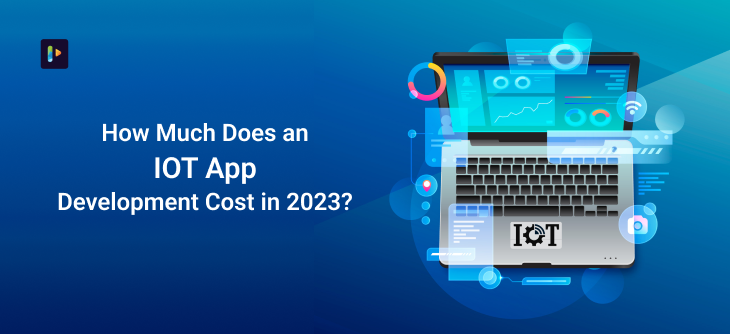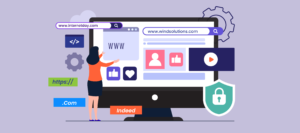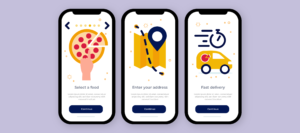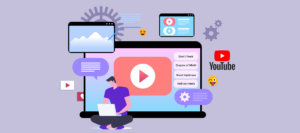Technology is constantly evolving. Whatever the industry, whether healthcare, home automation, education, IT, or any other, technology is making a significant impact. The people’s willingness to adopt new technologies makes various technological breakthroughs successful.
Regarding IoT, multiple devices are linked to building a network connected to the internet. Due to its success, IoT adoption is expanding rapidly across several industries. Additionally, several industries, like Samsung, Intel, Qualcomm, Apple, Google, LG, and others, are concentrating on the IoT App Development.
By the end of 2022, it is anticipated that corporations will spend $1.1 trillion worldwide on the Internet of Things. According to figures from Ericson, we will see a situation in the future where the number of linked IoT devices will match the number of mobile phones (Android, iOS).
With the current stats and demand for IoT technology, many firms are looking for information on IoT app development cost and IoT project cost estimation. As a result, this article discusses how to develop IoT apps, how much it costs for businesses to use IoT, and how IoT app development services may help you automate company processes. Let’s begin with the basics!
IoT App Development Cost Influencing Factors
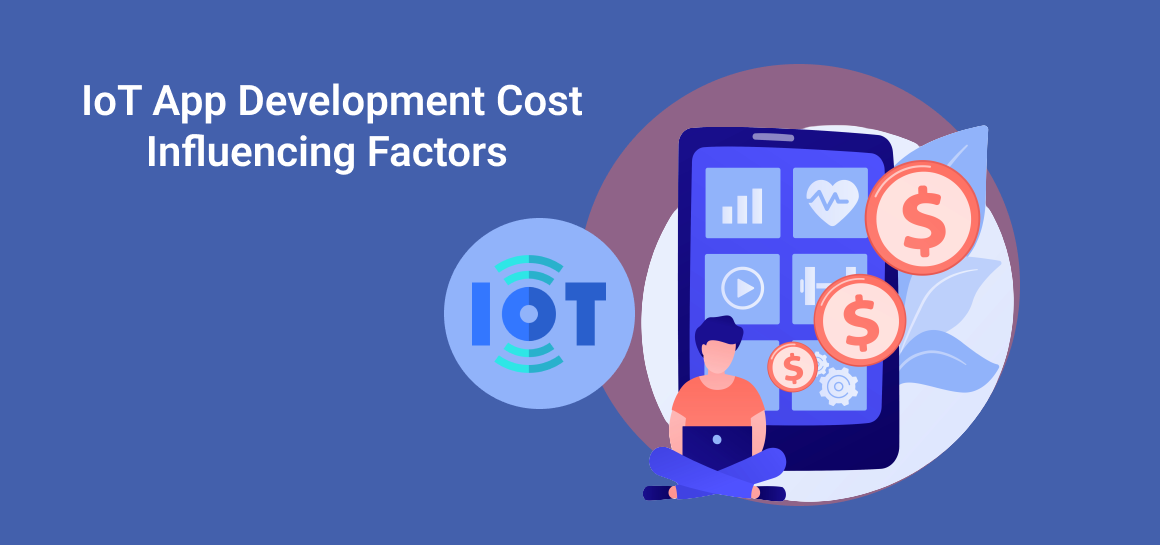
Depending on the type of IoT development, the average cost of an IoT app might be anywhere from $20,000 and $60,000. For instance, IoT monitoring devices and systems would cost $25,000. Additionally, the cost of IoT would be between $50,000 and $80,000 for complete corporate automation.
Similar to how IoT app development costs vary depending on specific aspects, IoT implementation costs also do. The most frequent elements influencing your development costs are listed below:
1. IoT back-end & infrastructure:
A back-end is required for any IoT system to process the data gathered from IoT devices. Either create a web server from scratch or leverage an existing cloud platform. Using a third-party cloud server offers greater flexibility and lower costs than creating a web server from scratch. You will require strong back-end development to support your system.
2. IoT hardware cost:
Consult with your IoT partner about the parts and design of your IoT device or sensor if you want to reduce expenses. The IoT hardware prototype is delivered to manufacturers after it is finished. Some IoT projects may spend up to 70–80% of their overall budget on hardware development alone.
In either case, certification of your IoT devices is a crucial element. Before being released, an IoT device must demonstrate compliance with international standards through certification.
3. IoT app development Functionality:
The following factors should be considered when organizing the development of your app:
- Consider the essential features
These are necessary for your app to operate (for example, a real-time map displaying the equipment movement is crucial for a traffic management app). Consider how a user will interact with your app and how you may best meet his demands.
- Decide on your points of differentiation
A 3D construction site map can occasionally set your software apart from the competition. It makes sense to include it on your feature list in this situation.
4. IoT development team size & time:
Your IoT development budget will be strongly impacted by the size and composition of your team.
Those in a full-fledged IoT development team are:
- System Architect;
- hardware designer;
- engineers who work with embedded software (firmware);
- back-end programmer;
- front-end programmer
- A mobile app developer
- UX and UI designer;
- the project manager;
- QA engineer
What Does It Cost to Develop IoT Apps?
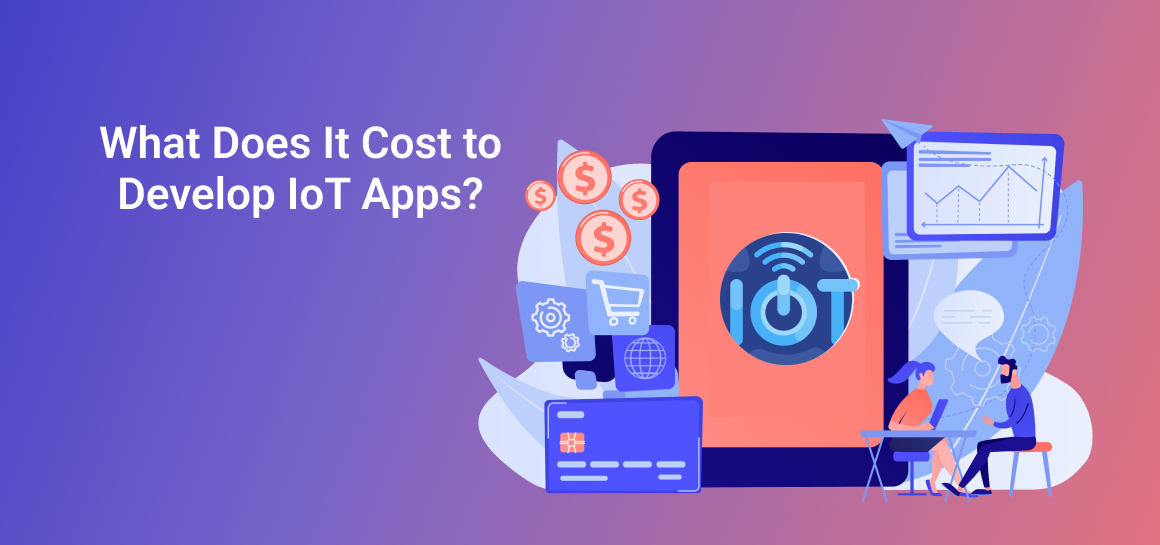
The cost of developing an Internet of Things application will vary depending on how complex the development is, determined by the number of features included in the IoT app solutions.
The price range for the IoT app that falls into the simple category will be between $30 and $40,000. This is due to the app’s limited device connectivity options and lack of other functionality beyond the essential connection and information rendering.
On the other hand, a complex app is one where IoT app developers will add various features like – geolocation, payments, synchronization across devices, third-party API integration, data encryption, new technologies auto-learning feed, content management system, data ingestion sources, and requirements for reporting granularity and reinforced security standards, aside from several other high-end ones, will cost between $50,000 and 80,000.
The price to create an IoT-based app or the IoT cost structure varies by nation and business. The organization’s size, the average developer hourly rate, the size of the developing country, and other factors all affect the development process for IoT applications.
| Nation | Development Cost |
| Middle East | $20,000 – $50,000 |
| USA | $25,000 – $60,000 |
| India | ₹10,00,000 – ₹30,00,000 |
After examining the current state of the IoT market, the platforms that can be used to develop IoT apps, the ways that businesses may profit from the IoT ecosystem, and the elements that define the IoT cost as well as the cost structure of an IoT application, it is time to examine a problem that is holding back the technology from realizing its full potential and how you and your IoT application development company can resolve it.
Several obstacles and presumptions surrounding the IoT market are believed to hinder widespread adoption across businesses. Let’s examine what they are currently and determine the likely remedy for those difficulties.
Challenges Affecting IoT App Solutions
Here are a few examples of IoT app development difficulties you could encounter when creating IoT-based systems and applications.
- Lack of Clearly Defined IoT Standards
Even though there are numerous IoT standards under development, there is still a severe shortage of a global standard in the IoT sector. There is no other option except to wait in this situation.
- High Investment Costs
It is advised to have numerous “bite-sized” IoT deployments with clear milestones and affordable costs to control the cost of IoT development. Start with minor stages and then invest in roll-out phases. To further reduce costs, we suggest software-as-a-service and shared infrastructure to our clients.
- Effective Communication Infrastructure in All Locations
Although using a cellular gateway to link IoT seems excellent, it is challenging to implement everywhere since only some users have optimal phone reception. Building infrastructure is the answer to this problem, but this can also be costly. Therefore, using LTE-NB and LTE-M, which use the current cellular towers to provide significantly more comprehensive coverage, is an alternative.
- Post-Launch and Maintenance
Testing and deployment are only the beginning of IoT app development. After creating an IoT application, there are additional problems related to post-production and maintenance. You must upgrade the app with the newest features and services to keep current with trends and technology. We know the firm you choose will determine the maintenance and post-launch support.
Future of IoT Development for Enterprises
IoT has the potential to significantly advance the field of developing mobile applications, advancing every industry in the future. Here are the top IoT trends that are moving businesses to new levels of success
1. Artificial Intelligence:
Supporting AI software is one of the most intriguing applications of IoT technology. There is a symbiotic relationship between artificial intelligence and IoT. IoT and AI benefit from better management in the IoT, which benefits from distributed data in AI.
2. Edge Computing:
Edge computing is essential for real-time applications. Edge networks handle information closer to the user and reduce network strain for all users by processing information locally rather than centrally. In addition to lowering IoT technology’s latency, edge computing can improve data processing security.
3. IoT Connectivity:
Wireless data rates have been the key obstacle that IoT networks have overcome in recent years. The components of IoT technology, such as sensors, edge computing, wearables, smart homes, and more, will advance as these technologies do. Newer connectivity types now have more infrastructure, which increases IoT solutions’ viability. These include connectivity technology, including satellites, WiFi 6, LPWAN, and 5G.
4. Smart Cities:
When creating networks for smart cities, IoT technology has various uses. One of the most critical challenges is traffic monitoring. It is possible to better control intersections for improved traffic optimization by monitoring traffic using sensors across the city. Monitoring water levels can help alert the public to current and impending flooding.
5. Smart Homes:
The innovative home sector has revolutionized because of the popularity of Google Assistant, Amazon Echo, Apple’s Siri, and other digital assistants. At-home IoT technology has reached its peak by managing countless items like lighting, appliances, and even home security systems in 2022. Nevertheless, there is still a great deal of space for expansion, which we shall witness over the following few years. Mordor Intelligence projects that between now and 2025, the smart home market will grow at a CAGR of 25%, growing to a value of $246 billion.
6. Wearable IoT Technology:
Wearable IoT devices should be considered, even though sensors and edge devices are crucial for many IoT technology solutions. The most significant wearable IoT gadgets in 2022 will likely be smartwatches, earphones, and extended reality (AR/VR) headsets.
Final Words
Since there is a massive demand for IoT-based mobile apps from businesses across industries, IoT mobile application development is currently a trend. IoT app development has a promising future in various industries, including security, healthcare, smart homes, and automotive.
Now you have examined everything, the next step is to begin developing your own IoT solution. The IoT app developers at Pairroxz are familiar with the commercial side of the connectivity ecosystem.
FAQs
Question 1: What Is IoT App Development?
The Internet of Things (IoT) connects sensors and mobile devices to transform data into information that is valuable. By using real-time data analytics, IoT-based applications allow customers to gain a deeper understanding of a certain product or service.
Question 2: How to Create IoT Apps?
The vast majority of firms who intend to develop IoT applications frequently ask this issue. You must follow a five-step method in order to create an IoT app, which includes.
- Picking a platform
- Finalizing the hardware
- Choosing an app development platform
- Starting design and development
- Testing, maintaining, and launching an application
Question 3: What Does It Cost to Develop IoT Apps?
IoT app development typically ranges in price from $15,000 to $60,000, depending on the requirements, scope, features, complexity, etc. of the project. Therefore, you need contact with the experts at an IoT app development business to determine the actual pricing of your IoT app.
Question 4: How are IoT Applications Helpful to Businesses?
In the modern world, the Internet of Things has taken on a critical role in our daily life. The following are some advantages of IoT app development for business:
- Increased output and profit
- Increased client satisfaction
- Application security for businesses
- Cost control

